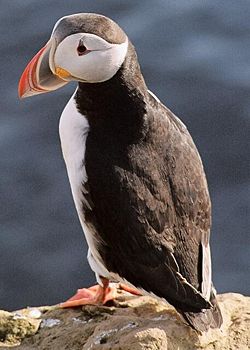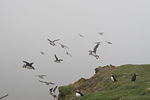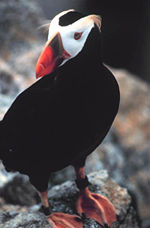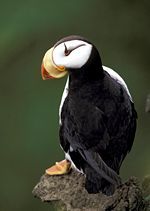Puffin
2008/9 Schools Wikipedia Selection. Related subjects: Birds
| Puffin | ||||||||||||
|---|---|---|---|---|---|---|---|---|---|---|---|---|
 Atlantic Puffin (F. arctica)
|
||||||||||||
| Scientific classification | ||||||||||||
|
||||||||||||
| Species | ||||||||||||
|
Fratercula arctica |
Puffin describes any of three auk species (or alcids) in the bird genus Fratercula (Latin: little brother — probably a reference to their black and white plumage, which resembles monastic robes) with a brightly colored beak in the breeding season. These are pelagic seabirds that feed primarily by diving. They breed in large colonies on coastal cliffs or offshore islands, nesting in crevices among rocks or in burrows in the soil. The Tufted Puffin was formerly placed in the genus Lunda.
All three puffin species have large bills. They shed the colourful outer parts of their bills after the breeding season, leaving a smaller and duller beak. Their short wings are adapted for swimming with a flying technique under water. In the air, they beat their wings rapidly (up to 100 times per minute) in swift flight, often flying low over the ocean's surface.
Breeding
The male Atlantic Puffin builds the nest and exhibits strong nest site fidelity. Both sexes of the Horned Puffin help to construct their nest. The burrows of the Atlantic and Horned Puffin are usually about 1 metre (3 feet) deep, ending in a chamber, while the tunnel leading to a Tufted Puffin burrow may be up to 2.75 metres (9 feet) in length. The Atlantic Puffin burrow is usually lined with material such as grass, leaves and feathers but is occasionally unlined. The eggs of the Atlantic Puffin are creamy white but can be occasionally tinged in lilac.
Puffins form long-term pair bonds. The female lays a single egg and both parents incubate the egg and feed the chick. The incubating parent holds the egg against its brood patch with its wings. The chicks fledge at night. After fledging, the chicks spend the first few years of their lives at sea, returning to breed after three to seven years.
Like many auks, puffins eat both fish and zooplankton, but feed their chicks primarily with small marine fish several times a day. The puffins are distinct in their ability to hold several (sometimes over a dozen) small fish at a time, crosswise in their bill, rather than regurgitating swallowed fish. This allows them to take longer foraging trips, since they can come back with more energy for their chick than a bird that can only carry one fish at a time.
Species

Three species are recognized today:
- Atlantic Puffin, Fratercula arctica
- Horned Puffin, Fratercula corniculata
- Tufted Puffin, Fratercula cirrhata
The genus Fratercula probably evolved in the northern Pacific, like most lineages of auks. However, at least 2 undescribed prehistoric species are known to have lived in the western Atlantic comparatively soon after the genus' emergence:
- Fratercula sp. 1 (Yorktown Early Pliocene of Lee Creek Mine, USA)
- Fratercula sp. 2 (Yorktown Early Pliocene of Lee Creek Mine, USA)
Another extinct species, Dow's Puffin (Fratercula dowi) was found on the Channel Islands of California until the Late Pleistocene or Early Holocene. It is possible that it became extinct due to overhunting and egg-collecting by early human settlers.
In culture
- There are several islands around the world called Puffin Island.

